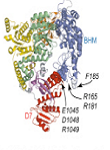|
|
|
Mfd and UvrD proteins: essential mediators to the maintenance of life
|
|
|
|
|
|
|
|
|
|

|
|
|
|
Nerea Sanvisens-Delgado, PhD
|
|
|
|
University of California, San Francisco
|
|
Helen Diller Family Comprehensive Cancer Center, UCSF,
1450 Third Street, San Francisco, CA 94117, USA
|
|
sanvisensn@gmail.com
|
|
|
|
|
|
|
|
|
|

|
|
In our bodies, DNA is damaged for a variety of genotoxic agents including UV radiation in sunlight, and thus DNA-repair systems are fundamental to the maintenance of life. In human cells, this damage is removed exclusively by the nucleotide excision repair mechanism (NER). NER can be divided into two subpathways: global genomic NER (GG-NER or GGR) and transcription coupled NER (TC-NER or TCR). In transcription-coupled repair (TCR), NER occurs most rapidly in the template strand of actively transcribed genes. This work is focused in the use of eXcision repair-sequencing (XR-seq), an excision repair sequencing methodology to map the location of repair sites in different Escherichia coli (E. coli) strains. Using XR-seq, Adebali et al. have dissected the accurate role of two important excision repair proteins, Mfd and UvrD, confirming their role in repair of UV-induced damage. Genome-wide analysis of the transcribed strand/nontranscribed strand (TS/NTS) repair ratio demonstrated that, deletion of mfd globally shifts the distribution of TS/NTS ratios downward by a factor of about 2 on average for the most highly transcribed genes. These results indicate that Mfd-dependent TCR is widespread in the E. coli genome, whereas UvrD plays a role in excision repair by aiding the catalytic turnover of excision repair proteins.
|
|
|
|
|
|
|
|

|
|